YOUR BEE QUESTIONS ANSWERED!
As part of Bee Aware Month 2022 we collected questions for our beekeeping experts to answer.

(Question from Tessa, aged 8)
Answer from Ken Brown, Auckland Beekeepers Club:
Yes, they do! Honey is the bees’ favourite food. It is the main thing that they eat.
They collect nectar from flowers and change it into honey and store it in their hive. We take what they don’t need and put it in jars.
When bees are flying around, they need lots of energy, so they eat honey which is full of different types of sugars. It is very good for them.
Ken is an Apiculture Land Based Training tutor and Vice President of the Auckland Beekeepers Club.

(Question from Johanna, Wainuiomata)
Answer from Ken Brown, Auckland Beekeepers Club:
It varies throughout the year, as beekeeping is very seasonal. It takes up to an hour to check a hive in your garden. This should be done every ten days in the spring to check for swarming. In winter, they should be checked only once every 4-5 weeks. In the summer it’s more like every two weeks. When it’s time to harvest the honey and put it into jars, this can take all day.
However, if you really get into beekeeping, you may spend time building hiveware, reading about bees, learning about bees, gardening, and visiting friends who keep bees.

(Question from Angus, 7)
Answer from Ricki Leahy, West Coast beekeeper and Apiculture NZ Life Member:
Bees collect pollen because it is a good protein food for their brood (babies) back in the hive.
Bees are one of the best pollinating insects.
They need lots of pollen and collect it from only one type of flower on each trip from the hive.
As they forage inside the flowers, gathering pollen, the bees get covered in pollen. This pollen rubs off as they visit from flower to flower. This pollinates flowers which then grow into the fruit and seeds that we eat.
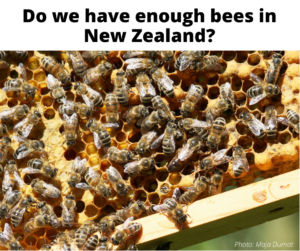
(Question from Amyrose, Waiwhetu)
Answer from Karin Kos, CEO of Apiculture New Zealand:
New Zealand is in the fortunate position of having plenty of bees, with over 720,000 registered hives sited around New Zealand. And we have around 10,000 beekeepers looking after those hives.
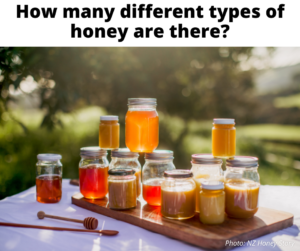
(Question from Eleanor, aged 9)
Also, what do different types of honey taste like and is it made by different bees and animals? (Tessa, aged 8)
Answer from Maureen Conquer, Apiculture NZ honey competition head judge:
Honey can have many different colours, smells and flavours. Bees get nectar from different types of flowers and this gives the different flavours of honey. There are as many types of honey as there are flowers that have nectar.
Different weather and soil can also change the flavour of honey.
Honey can be sweet with floral or fruity flavours. Other honey might taste earthy or spicy.
Pale honey usually has a milder flavour than darker honey.
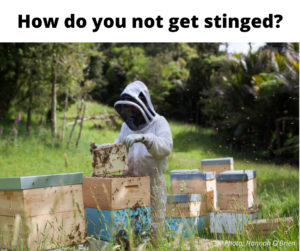
(Question from Sera-Dawn, aged 10)
Answer from Ken Brown, Auckland Beekeepers Club:
That is a very good question, that I often ask myself, after having been stung!
We avoid being stung by wearing a beesuit, which is like overalls with a veil to protect the face. We also wear gloves and boots. These are made from a material that is too thick for a bee’s sting to get into. We also use a smoker. The smoke calms the bees so that they are less likely to sting.
I usually only get stung if I’m careless and forget to put on my gloves or do the zips on my beesuit up. Beekeepers get used to being stung and don’t notice after a while.
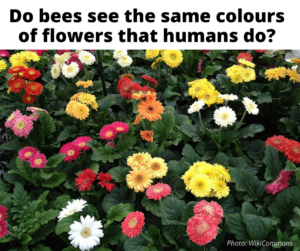
(Question from Fouad, Facebook)
Answer from Phil Lester, Te Herenga Waka (Victoria University of Wellington) School of Biological Sciences:
Bees see flowers very differently from you and me.
In technical terms, a bee will see light wavelengths from 300 to 650 nanometers (nm). These wavelengths are a little different from those our eyes can see. We see a spectrum of colours ranging from 390 to 750 nm.
That means that bees can’t see reds. But they can see in the ultraviolet spectrum (which we cannot). So many flowers can look completely different to a bee than to us. To a bee a flower can have a range of different colours and even different patterns that we cannot see.
If you can, check out https://www.youtube.com/watch?v=2gduA3EM26M&t=106s which shows you just how different many flowers look to insects such as bees.

(Question from Tessa, aged 8)
Answer from Ricki Leahy, West Coast beekeeper and Apiculture NZ Life Member:
Yes, bees do like humans if humans are being kind and gentle to them.
When you approach a beehive, you mustn’t do anything that may frighten the bees.
If you throw stones or poke a stick at the hive the bees will come out buzzing. They will chase you away to protect their hive.
Beekeepers always work with their bees gently to keep them nice and calm.
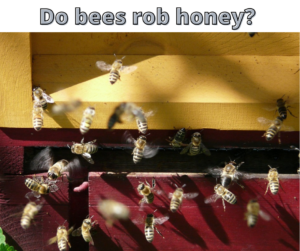
(Instagram question)
Answer from Ken Brown, Auckland Beekeepers Club:
Yes, they do. There are many other animals (mice, wasps, ants and bears) that try to steal honey from a beehive and other bees do too. After all, it does take time and effort to ripen nectar into honey. There are guard bees at the entrance to protect the hive. However, in the autumn when there isn’t any nectar about, bees will be much more likely to rob other hives. A weak hive may not be able to stop robber bees from stealing all their honey; most of the defenders will die trying to protect their hive. Quite often, a hive will be weakened by bee diseases and when it gets robbed it can spread the diseases.
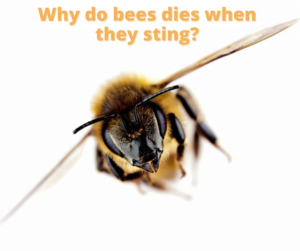
(Question from Angus, 7)
Answer from Phil Lester, Te Herenga Waka (Victoria University of Wellington) School of Biological Sciences:
The honey bee stinger is like a hypodermic needle, but with two rows of saw-toothed blades that are used to scissor their way into the animal when the bee stings. These blades are shaped like barbs on a fish-hook. When they sting a human, the barbs cause the sting to become stuck. The bee cannot remove the stinger from the skin of humans and other mammals. When the bee tries to fly off after stinging us, the bees internal organs are ripped out. Not a fun way to die!

(Question from Joel, Christchurch)
Answer from Dr Linda Newstrom-Lloyd of Trees for Bees:
Trees for Bees NZ has many favourites. Here are some of the best:
Good nectar sources – rosemary, lavender or fruit trees like pear, apple, quince, and citrus.
Good native plant nectar sources – rewarewa, tawari and rata.
Good pollen sources for spring – male willows and native five finger.
Good resources in autumn – fennel, hebe and lacebark.
For more information https://treesforbeesnz.org/star-performer-bee-plants

(Question from Isaac, 9, Wainuiomata)
Answer from Taranaki beekeeper Francis Proffit:
You can spot a queen bee in a hive because she has a longer abdomen than a worker bee. This makes her slightly bigger (about 2cm). Worker bees can only sting once but the queen bee can sting more than once because she does not lose her sting (a bit like a wasp).

(Question from Frances, Waiwhetu)
Answer from Ken Brown, Auckland Beekeepers Club:
No & Yes. Most bees get their sugar or carbohydrates from the nectar in flowers, which they eat and feed to their young. When the bee adds enzymes and dries the nectar, we call it honey. Many bees make honey, but only a few makes so much that we can collect it and put it in jars. We call these honey bees. Honey bees live in large colonies of tens of thousands of bees and work together to make honey.
Our native bees are solitary bees and feed their babies nectar. Bumblebees make honey (in a different way than honey bees), but only enough to feed their young. So, there isn’t a surplus for us to collect.

(Question from Cyrus, 9, Western Heights School)
Answer from Natasha Abram, Apiculture NZ Senior Policy Analyst
Bees can fly quite a long way to collect pollen and nectar. Bees usually only fly a couple of kilometres to get food and bring it back to their hive, but some bees can fly as far as five kilometres. If there is special pollen or nectar that they want to collect some bees may even travel ten kilometres or more.

(Question from Angus, 7)
Answer from Ken Brown, Auckland Beekeepers Club:
Nope! Although, it is more likely to be a bee. Bees are vegetarians and they visit flowers to get all their food – nectar and pollen. Wasps only get nectar from flowers (they also steal honey from beehives). So, bees spend more time on flowers. The good news is that honey bees are defensive and only sting if they feel threatened or to protect their hive. You’ll see other insects on flowers too, like bumblebees, native bees, butterflies, moths, beetles and lots of different types of flies.

(Question from Scarlett, 7, Western Heights School)
Answer from Ricki Leahy, West Coast beekeeper and Apiculture NZ Life Member:
First you must understand that there are four stages to the bee’s life cycle. Egg, larva, pupa and then adult.
All bees start off as a tiny egg which after three days hatches into a larva.
To grow a larva into a queen bee the worker bees have to nurse and feed the larva with a special nutritious food called royal jelly.
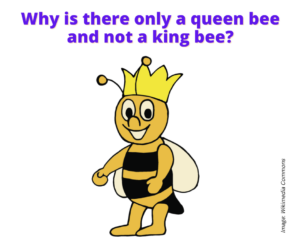
(Question from Madeleine, 9, Western Heights School)
Answer from Ken Brown, Auckland Beekeepers Club:
Bees have evolved to make sure they survive. One way they do this is that the queen only goes out of the hive to mate once. She will then stay in the hive and lay eggs for the rest of her life (unless she swarms). So, she doesn’t need a king. Up until a couple of hundred years ago it was thought that the king ruled the hive, but we now know it’s a queen.

(Question from Sia Zhang, 9, Western Heights School)
Answer from Ken Brown, Auckland Beekeepers Club:
The queen bee lives longest of all the bees in a hive. She can live up to 6 years, but usually it’s less than this. Normally a queen would live up to three years in a managed beehive. Bees don’t live very long, so it’s important that the queen bee keeps on laying lots of eggs (about 1,500 per day in the spring) to keep up bee numbers. When she slows down or stops laying, the worker bees will replace her with another queen. This makes sure that the hive survives.
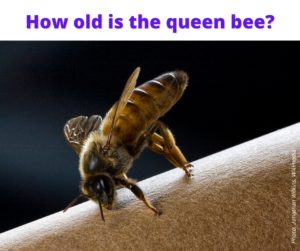
(Question from Manhalah Adil, 8 & Isabella, 8, Western Heights School)
Answer from Ken Brown, Auckland Beekeepers Club:
Sort of, but not directly. Bees pollinate some plants by moving pollen between them, which helps them to reproduce. Mushrooms don’t have pollen, they reproduce using spores, which is wind-blown. However, bees and mushrooms both live in the same environment and are part of the cycle of life. The plants that bees do help to grow will put nutrients into the soil that feeds mushrooms. Also, there are some fungi (the group that includes all mushrooms) that help protect the bees against diseases. So, they do help each other.
